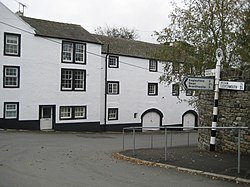Greysouthen: Difference between revisions
Created page with "{{Infobox town |name=Greysouthen |county=Cumberland |picture=The Old Punchbowl Pub in Greysouthen.jpg |picture caption=The Old Punchbowl Pub in Greysouthen |os grid ref=NY0712..." |
No edit summary |
||
| Line 21: | Line 21: | ||
===Mining=== | ===Mining=== | ||
Evidence of settlers digging for coal across west | Evidence of settlers digging for coal across west Cumberland can be dated back to the 13th century. Evidence of mining for coal within the Greysouthen area can be seen from the late 16th century. | ||
The largest portion of Greysouthen's coal lease was sold to William Walker & Company in 1787. The business continued to remain profitable for the next 80 years. In 1800 another firm took claim to a portion of the Greysouthen coal extraction industry. Wilson & Company invested in another colliery within Greysouthen. The two collieries distributed coal tokens which represented the success of the mines. Between these two mines a feud broke out over mine space. Wilson & Co was fined £16,000 damages over illegally mining William Walker & Company's land. This was a notorious case with much public interest in it. | The largest portion of Greysouthen's coal lease was sold to William Walker & Company in 1787. The business continued to remain profitable for the next 80 years. In 1800 another firm took claim to a portion of the Greysouthen coal extraction industry. Wilson & Company invested in another colliery within Greysouthen. The two collieries distributed coal tokens which represented the success of the mines. Between these two mines a feud broke out over mine space. Wilson & Co was fined £16,000 damages over illegally mining William Walker & Company's land. This was a notorious case with much public interest in it. | ||
Revision as of 10:25, 22 December 2018
| Greysouthen | |
| Cumberland | |
|---|---|
 The Old Punchbowl Pub in Greysouthen | |
| Location | |
| Grid reference: | NY071291 |
| Location: | 54°38’53"N, 3°26’28"W |
| Data | |
| Population: | 631 (2011) |
| Post town: | Carlisle |
| Postcode: | CA13 |
| Dialling code: | 019000 |
| Local Government | |
| Council: | Cumberland |
| Parliamentary constituency: |
Copeland |
Greysouthen (pronounced: "Grey-soon") is a village in western Cumberland, which is to be found between the towns of Workington and Cockermouth. This is an old coalmining village, though the mine closed in 1886.
History
John Marius Wilson's 1870 Imperial Gazetteer described Greysouthen as a settlement of 136 houses, an agricultural implement factory, a Quakers' chapel, a Wesleyan chapel and a flax mill. In 1901 Greysouthen civil parish had an area of 1,558 acres[1]
Mining
Evidence of settlers digging for coal across west Cumberland can be dated back to the 13th century. Evidence of mining for coal within the Greysouthen area can be seen from the late 16th century.
The largest portion of Greysouthen's coal lease was sold to William Walker & Company in 1787. The business continued to remain profitable for the next 80 years. In 1800 another firm took claim to a portion of the Greysouthen coal extraction industry. Wilson & Company invested in another colliery within Greysouthen. The two collieries distributed coal tokens which represented the success of the mines. Between these two mines a feud broke out over mine space. Wilson & Co was fined £16,000 damages over illegally mining William Walker & Company's land. This was a notorious case with much public interest in it.
By the start of the 19th century Greysouthen's thriving mining industry had become the sole employer. To house miners, small rows of cottages were built within the town. In 1823 Joseph Birbeck and J.W. Flecter began mining in Greysouthen. A tax value of £20 was introduced for the annual lease of 400 tons of coal. For every ton mined over this, an additional tax of 1 shilling was applied.[2]
The Melgramfitz pit was closed in 1886, which led to the end of the Greysouthen as a coal mining community.[1] This was followed by a decline in the population.
Greysouthen's 19th-century miners were hard-drinking men, not unknown amongst miners, and the magistrates' concern was recorded..[3]
Community
Today, Greysouthen is surrounded by farmland through which two streams run. The village is divided into two by the local residents – "up the went" and "down the went". The 'went' is a hill at the centre of Greysouthen.
The village's few services include a village hall which is no longer used as a Post Office on Monday afternoons being replaced in 2015 by a mobile van, but other events are held at the hall. St Josephs Roman Catholic Church is approximately three miles from the centre of the village.
Greysouthen has one large playing field with an adventure playground, football pitch, and a garden commemorating the Queen's Silver Jubilee.
There are seven beaches within ten miles of Greysouthen, Siddick is the closest at about five miles; the second closest is Maryport then Workington, Allonby South, Allonby, Parton and Whitehaven.
Wildlife
The Greysouthen area supports a variety of bird species including northern lapwings, snipes, curlews, woodpigeons, buzzards, oystercatchers, pheasants, sparrowhawks, and quail. Red squirrels are also found. Orange tips, red admirals, and painted lady butterflies occur within the area.
Locally growing west Cumberland wild plants include the greater butterfly orchid, early purple orchid and yellow rattle.
Outside links
| ("Wikimedia Commons" has material about Greysouthen) |
References
- ↑ 1.0 1.1 "The Flectchers". Bulmer's History & Directory Of Cumberland, 1901. http://www.fivenine.co.uk/local_history_notebook/Broughton%20Cross/fletchers.htm. Retrieved 2 May 2013.
- ↑ Mining history explained
- ↑ "Greysouthen", Visitoruk.com
